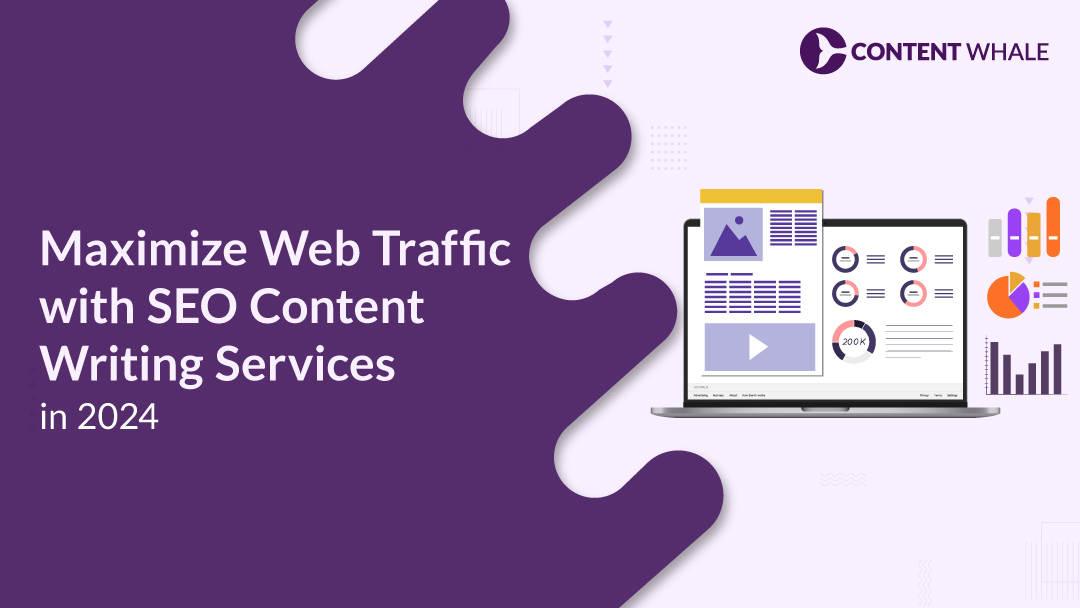To increase website traffic in 2024, focusing on SEO content creation is key. Creating content that aligns with search intent helps improve organic website traffic and boosts your site’s search engine rankings. By combining keyword research strategies with effective content marketing tactics, businesses can optimize their presence on search engines and attract a steady flow of visitors. This blog explores actionable strategies for SEO content writing that help businesses achieve higher visibility and better engagement, ultimately driving more traffic to their websites.
1. The Impact of SEO Content Writing on Organic Traffic
SEO content writing is a powerful tool that directly contributes to increasing organic website traffic. Let’s break down how this happens:
A) Aligning Content with Search Engine Algorithms
By optimizing content for search engine rankings, websites can attract more visitors who are actively searching for information. Incorporating the right keywords and adhering to SEO optimization principles makes it easier for search engines to understand and rank your content.
B) Addressing User Intent
Understanding and meeting user intent is crucial. When your content addresses the questions or needs that users have, it boosts content engagement, leading to longer visit durations and lower bounce rates—both of which improve your standing in SERP rankings.
C) Building Authority with Quality Content
Quality content that is informative, relevant, and engaging builds authority over time. Effective SEO content creation focuses on answering user queries, enhancing user experience, and establishing your site as a trusted resource. This increases your visibility and brings steady organic traffic.
2. Optimizing for High-Traffic Keywords in 2024
In 2024, keyword research is evolving, and high-traffic keywords remain essential for increasing organic website traffic. However, the focus is not solely on search volume but also on matching user intent and finding long-tail keywords that convert.
| # | Keyword Tool | Key Features | Best For | Price Range |
| 1 | SEMrush | Competitor analysis, keyword difficulty, backlink tracking | Comprehensive SEO analysis | $119.95/mo to $449.95/mo |
| 2 | Ahrefs | Keyword difficulty, content gap analysis, site audits | Backlink and keyword research | $99/mo to $999/mo |
| 3 | Google Keyword Planner | Free keyword ideas, search volume, and competition level | Beginner keyword research | Free |
| 4 | Moz Keyword Explorer | Keyword suggestions, SERP analysis, opportunity scores | Easy-to-use keyword insights | $99/mo to $599/mo |
| 5 | AnswerThePublic | Visual representation of keyword questions, great for brainstorming ideas | Content idea generation | Free to $99/mo |
Key Strategies for Keyword Research
Understand User Intent
- It’s vital to align keywords with what users are looking for. Search engines prioritize content that accurately addresses user queries.
- Categorizing keywords by intent—informational, navigational, transactional—helps ensure you target the right audience at the right stage.
Target Long-Tail Keywords
- While long-tail keywords may have lower search volumes, they often bring more targeted traffic with a higher likelihood of conversion.
- For example, instead of focusing solely on “best laptops,” using long-tail variants like “best budget laptops for students” narrows down the audience and increases the chances of attracting engaged visitors.
Leverage Keyword Clustering
- Grouping related keywords helps optimize a single piece of content for multiple queries.
- For example, a blog on “best SEO tools” can include clusters like “free SEO tools,” “AI-driven SEO tools,” and “SEO tools for small businesses,” improving the content’s relevance to various searches.
Advanced Tools for Keyword Research
- Google Keyword Planner and SEMrush
These tools provide valuable insights into search volumes, competition, and potential keyword opportunities. They help you discover high-traffic keywords that align with your content strategy while revealing low-competition niches you can target.
- Competitor Keyword Gap Analysis
Analyzing your competitors’ ranking keywords helps you uncover missed opportunities. Using tools like Ahrefs and SEMrush, you can find high-traffic keywords your competitors target and refine your strategy to outperform them.
3. The Role of Quality Content in SEO

Creating high-quality content is one of the most effective ways to increase website traffic in 2024. Quality content not only engages users but also improves your search engine rankings by providing value and relevance to your audience. Let’s break down why this matters:
What Makes Content High-Quality?
A) Relevant Information
In 2024, search engines prioritize content that directly addresses user intent. This means your content should align with what users are searching for, answering their questions comprehensively. Well-researched, valuable content helps boost organic website traffic by ensuring that users find exactly what they need.
B) SEO-Optimized Blog Writing
Well-structured blog posts are key to SEO optimization. Use on-page SEO tactics like keyword integration, meta tags, and proper headings to help search engines easily crawl your site. Additionally, incorporating long-tail keywords and creating content that is both informative and engaging can help your blog perform better in search results.
C) Why Quality Content Drives Traffic
- Improved User Engagement: High-quality content enhances user experience, which is vital for SEO success. When users spend more time on your website and interact with your content, search engines recognize your site as a valuable resource, improving your SERP rankings. This can lead to a significant increase in organic website traffic.
- Building Authority with Content: Websites that consistently publish in-depth, useful content on specific topics are rewarded with higher rankings. Establishing topical authority by covering a wide array of related subtopics with detailed information signals to search engines that your site is a credible source in your industry. This helps attract more traffic and improves your visibility.
D) Tips for Creating High-Quality Content
- Use Data and Insights
Incorporating data-driven insights and AI in SEO tools can help refine your content strategy, making it more relevant and optimized for both users and search engines. - Internal Linking Strategy
By linking related pages and resources within your content, you enhance both content engagement and SEO. An effective internal linking structure helps guide users through your website and improves how search engines crawl and index your content.
4. Enhancing Traffic with Technical SEO
Technical SEO plays a critical role in helping websites increase website traffic by improving the technical aspects that influence how search engines crawl, index, and rank your site. Let’s explore the key elements that can boost your traffic through technical SEO optimization.
A) Site Speed Optimization
- Faster websites perform better in search results, enhancing both user experience and organic website traffic. Slow-loading pages lead to higher bounce rates, which can negatively impact your search engine rankings.
- Tools like Google PageSpeed Insights and GTMetrix can help evaluate your site’s speed and suggest improvements like compressing images, minifying code, and enabling browser caching.
B) Mobile Optimization
- With mobile-first indexing, Google primarily uses the mobile version of your website for ranking. This makes mobile optimization essential for 2024. Implement responsive design to ensure your content adjusts to different screen sizes.
- Use tools like Google’s Mobile-Friendly Test to identify any mobile usability issues. A well-optimized mobile experience enhances content engagement and improves your rankings in mobile search results.
C) Meta Tags and Descriptions
- Effective meta tags, including title tags and descriptions, provide a clear signal to search engines about the content of your pages.
- Optimizing these meta tags for relevant keywords helps improve SERP rankings and encourages users to click on your links, ultimately driving more organic traffic.
D) Internal Linking Strategy
- A strong internal linking strategy distributes link equity across your site and guides users through different pages, improving navigation and on-page SEO.
- This boosts your site’s crawlability, ensuring that all key pages are indexed and ranked.
| # | Technical SEO Element | Best Practice | Recommended Tools |
| 1 | Site Speed Optimization | Compress images, minify code, leverage browser caching | Google PageSpeed Insights, GTMetrix, WebPageTest |
| 2 | Mobile Optimization | Use responsive design, optimize for mobile-first indexing | Google Mobile-Friendly Test, Lighthouse |
| 3 | Meta Tags Optimization | Write concise, keyword-rich meta titles and descriptions | Yoast SEO, All in One SEO, Rank Math |
| 4 | Crawlability | Ensure proper indexing, fix crawl errors, use robots.txt and XML sitemaps | Google Search Console, Screaming Frog |
| 5 | Structured Data | Add schema markup for rich snippets | Google Structured Data Testing Tool, Schema.org |
5. How Backlinks and Internal Links Boost Traffic

Both backlinks and internal linking play crucial roles in driving organic website traffic and improving search engine rankings.
Let’s look at how these two strategies contribute to traffic growth:
A) Backlinks: Driving Authority and Traffic
- High-Quality Backlinks: Backlinks are external links from other websites pointing to your site, and they act as a vote of confidence in your content.
- The more high-authority backlinks you acquire from reputable sites, the more search engines recognize your content’s value.
- This improves your SERP rankings and drives organic traffic to your site, as search engines prioritize content that others trust.
B) Referral Traffic
- Backlinks not only boost search rankings but also generate referral traffic from users who click on those links. Links from authoritative websites introduce your content to new audiences, further increasing the flow of organic website traffic.
C) Internal Links: Strengthening SEO and Engagement
- Distributing Authority Internally
While backlinks pass authority from other domains, internal linking helps you distribute authority across your site. By linking from high-performing pages to newer or lower-ranking pages, you boost their chances of ranking better. This strategy enhances the visibility of deeper pages and improves overall SEO optimization.
- Enhancing User Experience
Internal links create a seamless navigation experience for users, guiding them to relevant content and improving content engagement. When users find more related information through internal links, they tend to spend more time on your site, reducing bounce rates and positively impacting search engine algorithms.
D) Best Practices for Internal Linking
- Use Keyword-Rich Anchor Text
Incorporating keyword-rich anchor text helps both users and search engines understand the relevance of linked pages. This strengthens the SEO value of your internal links while improving on-page SEO.
- Link Strategically to Important Pages
Prioritize linking to key pages that need a visibility boost. Directing internal links from high-traffic content to important but lower-ranking pages can improve their rankings and attract more traffic over time.
6. Content Optimization for Voice and Mobile Search

As more users shift to voice search and mobile browsing, optimizing your content for these platforms is crucial to increase website traffic. Let’s explore how to adjust your SEO strategy for 2024:
A) Voice Search Trends for 2024
- Focus on Conversational Queries
Voice searches are typically longer and more conversational compared to typed searches. Users often ask direct questions like, “Where can I find organic produce nearby?” To capture this traffic, incorporate long-tail keywords and natural language throughout your content.
Structuring your answers in a question-and-answer format can also improve your chances of appearing in voice search results.
- Optimize for Featured Snippets
Many voice search results are pulled directly from featured snippets. Ensure your content answers user questions clearly and concisely by optimizing for structured data and targeting relevant snippets. This can significantly boost both SERP rankings and organic website traffic.
B) Mobile-First Content Creation
- Mobile Optimization is Essential
With over 50% of global website traffic coming from mobile devices, ensuring a seamless mobile experience is non-negotiable. Implement responsive design, optimize for page speed, and reduce load times to enhance the user experience on mobile. Mobile-first indexing by Google also means that a well-optimized mobile site is critical for improving your search engine rankings.
- Speed and Usability Matter
Voice search users expect quick, efficient responses. Slow-loading pages or poor mobile interfaces can hurt both your voice and mobile rankings. Compressing images, leveraging browser caching, and using a content delivery network (CDN) can improve your site’s speed, keeping users engaged.
7. Leveraging AI and Data-Driven Content Strategies
The rise of AI in SEO has revolutionized how businesses improve search engine rankings and increase organic website traffic. In 2024, using AI-driven tools has become a cornerstone of effective SEO strategies, helping businesses enhance both content quality and site performance.
A) How AI Enhances SEO
- Predictive Analytics and Trend Forecasting
AI tools can analyze historical data and identify patterns in keyword research strategies, allowing businesses to stay ahead of emerging trends. By predicting what users will search for next, AI helps businesses optimize their content before trends peak, ensuring they rank highly for new queries. - Real-Time SEO Adjustments
AI-driven SEO tools provide real-time insights into website performance, automatically adjusting meta tags, content layouts, and even on-page SEO tactics based on user interactions and search engine updates. This proactive approach keeps websites optimized without the delay of manual intervention, which is crucial for maintaining competitive SERP rankings.
B) Using AI for Content Creation
- Data-Driven Content Creation
AI can quickly generate SEO content creation ideas based on data, offering topic suggestions that align with content marketing tactics and search trends. By analyzing competitors and user behavior, AI helps businesses identify content gaps, ensuring they create articles that engage and rank effectively. - Content Optimization for Voice and Visual Search
AI also assists in optimizing content for voice and visual search. With the increasing use of voice assistants like Alexa and Google Assistant, AI tools help businesses tailor content to meet the needs of voice queries. Optimizing for conversational, long-tail keywords makes content more discoverable in voice search results, further boosting organic website traffic.
Conclusion

In 2024, using SEO content creation as a tool to increase website traffic is more effective than ever. With advancements in AI in SEO, predictive analytics, and real-time content adjustments, businesses can stay ahead of search engine algorithm updates and user intent shifts.
Focusing on keyword research strategies, creating high-quality, relevant content, Increase Website Traffic and leveraging technical optimizations like mobile optimization and site speed improvements ensures a website’s competitiveness in search rankings.
By implementing these strategies and regularly updating your SEO practices to reflect the latest trends, businesses can boost organic website traffic, enhance user engagement, and see significant growth in lead generation and conversion rates.
Staying agile in your content strategy and using SEO tools for ongoing optimization will be key to maintaining and growing your online presence in the ever-evolving digital space.
At Content Whale, we specialize in crafting SEO-optimized content that boosts organic website traffic and improves search engine rankings. Our team excels in producing high-quality, data-driven content through effective keyword research strategies and content marketing tactics customized for your business needs.
Let us help you increase your online visibility and drive traffic with well-structured, engaging content that converts visitors into leads. Reach out today!
FAQs
1. How can SEO content writing increase website traffic?
SEO content creation is key to improving organic website traffic. By optimizing your content for relevant keywords and aligning it with user intent, search engines rank your pages higher, making it easier for potential visitors to discover your website. Effective content incorporates well-researched long-tail keywords, relevant meta tags, and on-page SEO strategies to engage readers and enhance your site’s visibility in search engine rankings.
2. What type of content works best for SEO in 2024?
Content that balances high-quality information with SEO optimization tends to perform best. Detailed blog writing, step-by-step guides, and content marketing tactics tailored to answer specific user queries are particularly effective. Incorporating elements like structured data, videos, and social media traffic strategies can further boost your rankings.
3. How often should I update my SEO content?
Regular content updates—every 3 to 6 months—are essential for maintaining high search engine rankings. Refreshing your content to include updated statistics, new SEO tools, or emerging trends ensures relevance and continued content engagement. Performing periodic content audits can help identify areas that need optimization, such as adding fresh backlinks or enhancing website speed.
4. Is voice search important for SEO in 2024?
Absolutely! Optimizing for voice search has become a priority, as more users rely on virtual assistants like Alexa or Google Assistant. By using conversational long-tail keywords and ensuring your site is mobile-friendly with fast website speed, you can tap into this growing segment, further increasing organic traffic.
5. Can I handle SEO content writing in-house, or should I outsource it?
While handling SEO internally can be beneficial if you have a dedicated team, many businesses find outsourcing to professionals yields better results. External experts bring specialized knowledge of the latest SEO optimization practices, content marketing tactics, and keyword strategies, which can significantly enhance your lead generation and conversion rates.





